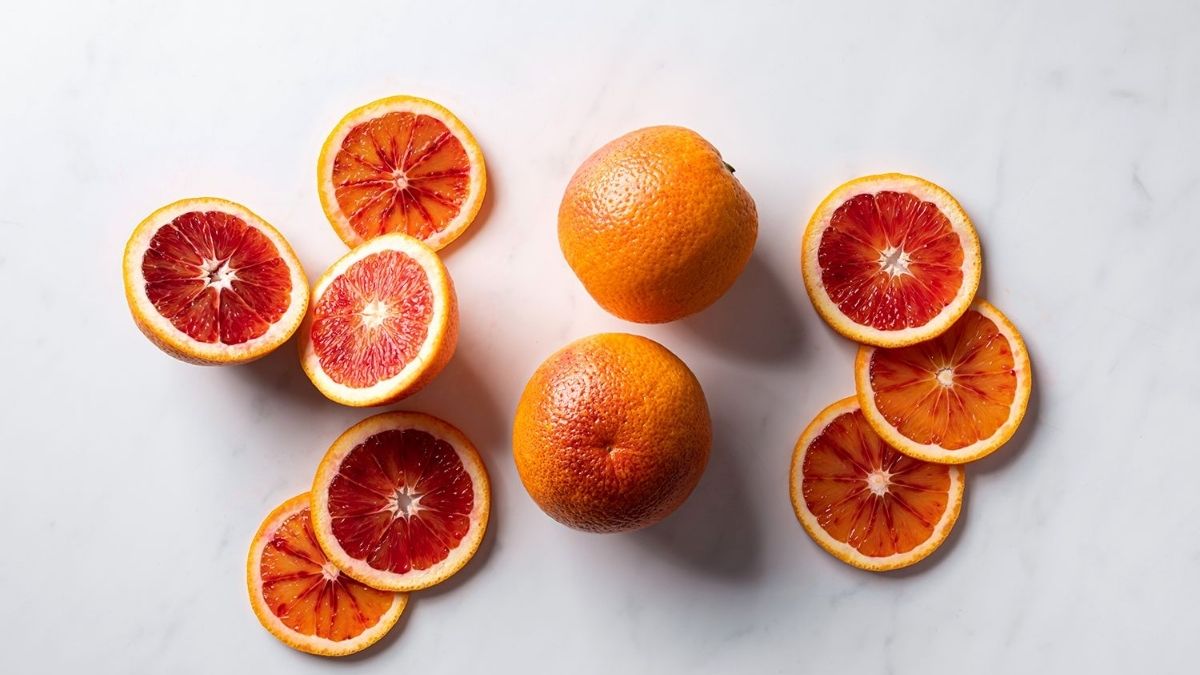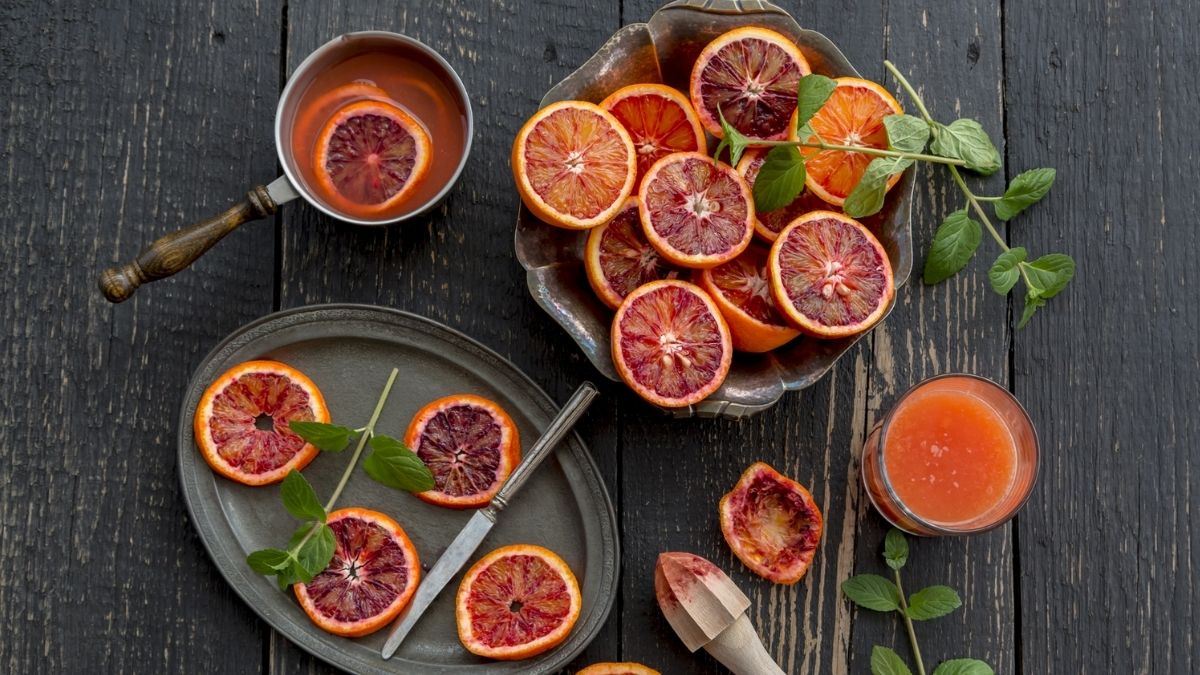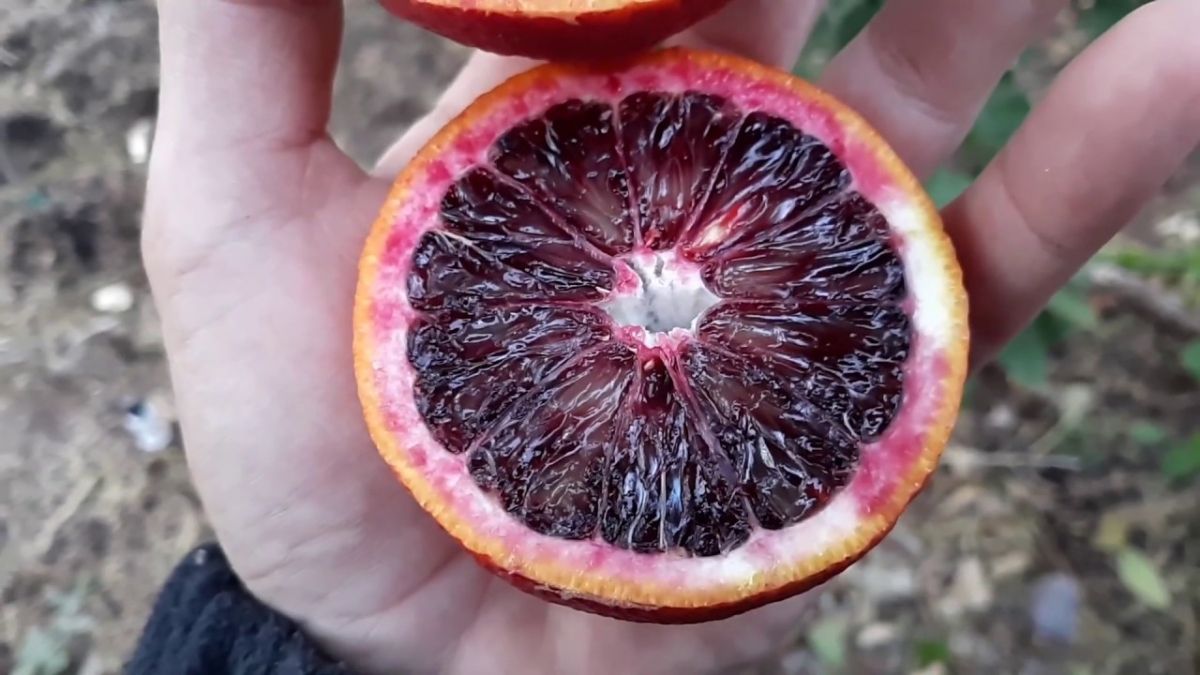Blood orange is a citrus fruit with crimson-colored flesh on the interior that looks like a typical orange on the outside. It gets its lovely red color from an anthocyanin pigment, which only appears when low night temperatures. Because anthocyanin develops first along with the peel and margins before moving interior, some blood oranges are streaked with crimson rather than solid red. The pigment also gives raspberries and blackberries their color. Blood oranges are thought to have originated in the southern Mediterranean. Because the fall and winter evenings are cool enough for anthocyanin to develop, the location is ideal for cultivating the fruit.
Blood oranges are a deliciously sweet and vibrantly colored citrus fruit with a horrific moniker. They’re a little smaller than regular oranges, with thick, pitted skin that may or may not have a reddish blush, but they look like other oranges on the inside. The flesh is a bright dark pink, maroon, or dark blood red on the interior.
Citrus plants in warm, temperate areas produce blood oranges. They are grown mainly in California and Florida in the United States and then shipped. Oranges can be eaten whole, juiced, or used in baked goods, drinks, salads, and other foods. Blood oranges have a notable and delectable raspberry edge to their flavor and stunning crimson color.
What is a Blood Orange?
Blood orange is a citrus fruit with a deep red colored fruit and juice that looks identical to orange on the outside. Anthocyanin, which forms when these citrus fruits ripen during warm days with chilly nights, is responsible for the red hue. Anthocyanin, the pigment that gives blood oranges their red color, develops along the peel’s margins, then follows the segments’ edges before migrating into the flesh.
Depending on the season, when they were collected, and the variety, blood oranges can be lined or streaked with crimson instead of blood-colored. Blood oranges are quicker to peel, have fewer seeds, and have a sweeter flavor than other oranges. Because they are only available from December to April, they are more challenging to come by and more expensive than naval or other common oranges.
Health Benefits of Blood Oranges
Although blood oranges have an ominous moniker, they are simply a natural mutation of regular oranges. Anthocyanins, which turn blueberries blue and blood oranges brilliant red, are produced due to this mutation. The blood orange was first grown in Italy, but it is now grown worldwide. While there are dozens of blood-orange kinds, the Moro, Sanguinetti, and Tarocco are the three most common in the United States. While each has its flavor, they all have the same nutritional value.
Blood oranges include antioxidants, minerals, and other elements that have a variety of health benefits. Vitamin C supports healthy blood vessels and muscles, which helps the body recuperate, and it’s also a crucial vitamin for boosting iron absorption.
Blood oranges also provide:
Antioxidants- Anthocyanins, an antioxidant, are abundant in blood oranges, and these are the pigments responsible for their dark red hue. Anti-cancer capabilities are well-known for these antioxidants, and they aid in reducing free radical damage, lowering the likelihood of cells becoming malignant.
Cholesterol Regulation- Vitamin C is abundant in blood oranges, as it is in many other citrus fruits. According to recent studies, this can help lower cholesterol levels. According to one study, taking vitamin C regularly can help improve your “good” HDL cholesterol levels while also lowering your “bad” LDL cholesterol.
Immune System Support- Another advantage of blood orange vitamin C is strengthening your immune system. Because vitamin C is water-soluble and your body cannot store it, it’s critical to obtain enough of it daily. Getting enough vitamin C regularly keeps your immune system, particularly your white blood cells, in good shape.
Protection Against Strokes- Another advantage of blood oranges’ vitamin C is that it helps to strengthen your immune system. Because vitamin C is water-soluble and your body can’t store it, it’s critical to obtain enough of it daily. Getting enough vitamin C in your diet regularly will assist your immune system, particularly your white blood cells, stay healthy.
How to Use Blood Oranges?
Blood oranges are deliciously eaten straight from the bag. Due to their vibrant hue is ideal for cutting into “supremes,” or membrane-free citrus slices. Blood oranges have a higher sugar content than regular oranges. Their juice is lovely, but it ferments quickly and should be utilized or consumed the same day because it’s sweeter than regular orange juice. Blood oranges can also be used as a garnish on drinks or in orange marmalade for a stunning impact. Nutrition. Antioxidants in blood oranges aid in minimizing oxidative stress and lower the risk of chronic illnesses like cancer, heart disease, and diabetes.
What do Blood Oranges Taste Like?
The taste of blood oranges varies depending on the kind you try. They have a flowery or tart flavor and are less sour than regular oranges. Orange juice with raspberry, cranberry, or fruit punch flavors may be found in some variations. Blood orange has the same mouthfeel as a conventional orange, but the segments contain fewer seeds. Blood oranges have a higher sugar content than regular oranges.
Their juice is lovely, but it ferments quickly and should be utilized or consumed the same day because it’s sweeter than regular orange juice. Blood oranges can also be used as a garnish on drinks or in orange marmalade for a stunning impact. The blood orange has a flavor similar to navel oranges but more flowery and acidic. Regular oranges are sweeter and less acidic than blood oranges. The flavor has been compared to that of raspberry by some.
Where can I Get Blood Oranges?
Blood oranges require a peaceful location with a hot season and cooler weather to bring forth their natural color. As a result, they thrive in the Mediterranean region, where they are said to have originated, and sections of California and Florida. Blood oranges are also harvested throughout the winter. In the United States, they’re most commonly available for purchase from December to April. However, that season may extend for a month, depending on the weather.
Blood oranges are widely available at farmers’ markets and specialized stores in places where they are cultivated. They’re usually sold in bulk, and you can get as many as you want. Blood oranges aren’t usually sold pre-bagged or in quantity because they’re more unusual than navel oranges. Look for blood oranges that are weighty for their size, like another citrus. If you have an option, choose blood oranges with darker, redder skins for flesh more likely to match the moniker.
Blood oranges can be grown at home in the right conditions (USDA Zones 9-10). Some trees grow in larger containers and can be carried indoors during chilly months. Full sun, wet soil, and a warm climate outdoors (60-85 degrees Fahrenheit) or a consistent average interior temperature of 65 degrees Fahrenheit are required for the plants.
Is Blood Orange a Grapefruit?
Grapefruit is a mix between an orange and a pomelo, whereas blood orange is an orange variation. Furthermore, the flavor of blood oranges is a combination of orange, raspberry, and cranberry, whereas grapefruit is recognized for its bitterness. Grapefruits are heavier and larger than sweet oranges (though, to be fair, there are also different types of grapefruit out there).
If you’re still not convinced, peel that fruit. Grapefruits have pink or red flesh, while sweet oranges have orange flesh. Grapefruit and orange In the early years, citrus breeders in California created several sweet orange X grapefruit crosses, which were given the name “orangelo,” a mix of orange and pomelo, the grapefruit’s original name. None of the hybrids were productive enough to be helpful in the garden.
Conclusion
Blood orange is a citrus fruit with a deep red colored fruit and juice that looks identical to orange on the outside. Anthocyanin, which forms when these citrus fruits ripen during warm days with chilly nights, is responsible for the red hue.
Blood oranges are a natural variation of the standard sweet orange. According to The National Gardening Association, the flavor of blood oranges is a combination between an orange and a raspberry. The high quantities of anthocyanin pigment in blood oranges give them distinctive colors. Other fruits and vegetables with red, blue, or purple-ish colors, such as blueberries, eggplants, beets, and purple cabbage, contain this highly colored pigment.


